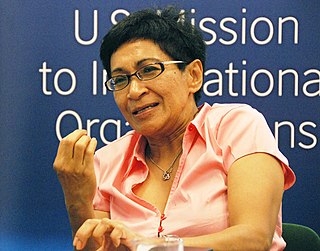
The Robert C. Byrd Green Bank Telescope (GBT) in Green Bank, West Virginia, US is the world's largest fully steerable radio telescope, surpassing the Effelsberg 100-m Radio Telescope in Germany. The Green Bank site was part of the National Radio Astronomy Observatory (NRAO) until September 30, 2016. Since October 1, 2016, the telescope has been operated by the independent Green Bank Observatory. The telescope's name honors the late Senator Robert C. Byrd who represented West Virginia and who pushed the funding of the telescope through Congress.
The Commonwealth Scientific and Industrial Research Organisation (CSIRO)'s radio astronomy observatories are collectively known as the Australia Telescope National Facility (ATNF), with the facility supporting Australia's research in radio astronomy. It is part of CSIRO's business unit known as CSIRO Space and Astronomy.

NASA's series of Great Observatories satellites are four large, powerful space-based astronomical telescopes launched between 1990 and 2003. They were built with different technology to examine specific wavelength/energy regions of the electromagnetic spectrum: gamma rays, X-rays, visible and ultraviolet light, and infrared light.

Astronomical Observatory of Trieste is an astronomical center of studies located in the city of Trieste in northern Italy.

South Africa’s National Research Foundation (NRF) is the intermediary agency between the policies and strategies of the Government of South Africa and South Africa's research institutions.
The Malaysian Centre of Remote Sensing (MACRES) was a Malaysian remote sensing centre. An agency under the Ministry of Science, Technology and Innovation (Malaysia). Its role was to provide data and solutions for remote sensing applications. In 1991, it was recognised as a federal institute of research in the field of remote sensing and related technologies. The main centre was located in Kuala Lumpur and the ground receiving centre was located in Mentakab, Pahang, Malaysia.

The National Space Agency, abbreviated ANGKASA, was the national space agency of Malaysia. It was established in 2002 and its charter aims to upgrade, stimulate and foster the country's space programme through integrated and coordinated efforts by developing and applying space technologies.

Padang Matsirat is a mukim in Langkawi, Kedah, Malaysia. It is situated on the western part of the island.

The Ministry of Science, Technology and Innovation, abbreviated MOSTI, is a ministry of the Government of Malaysia.
The Sky Polarization Observatory (SPOrt) was an Italian instrument planned for launch to the International Space Station in for a planned 2-year mission beginning in 2007. There it would observe 80% of the sky for the Cosmic microwave background radiation in the frequency range from 20 to 100 GHz. Apart from detecting large scale CMB polarization it will also provide maps of Galactic synchrotron emission at lowest frequencies.

The National Institute for Astrophysics is an Italian research institute in astronomy and astrophysics, founded in 1999. INAF funds and operates twenty separate research facilities, which in turn employ scientists, engineers and technical staff. The research they perform covers most areas of astronomy, ranging from planetary science to cosmology.
MYSA or variants may refer to:
The Malaysian Remote Sensing Agency, abbreviated MRSA or ARSM, was a department responsible for remote sensing under the Ministry of Science, Technology and Innovation (Malaysia). On 20 February 2019, the Malaysian Cabinet had approved the merging of the Malaysian Remote Sensing Agency (MRSA) and National Space Agency (ANGKASA) to establish of Malaysian Space Agency (MYSA).

Mazlan binti Othman is a Malaysian astrophysicist whose work has pioneered Malaysia's participation in space exploration. She was her country's first astrophysicist, and helped to create a curriculum in astrophysics at the national university, as well as to build public awareness and understanding of astronomy and space issues. She was appointed Director General of Angkasa, the Malaysian National Space Agency and served as the director of the United Nations Office for Outer Space Affairs in Vienna from 2007 to 2014.

Arthur C. Clarke Institute for Modern Technologies (ACCIMT) is an institute for research and technology transfer in Sri Lanka. It is named after its founder patron, Sir Arthur C. Clarke, the famous British science fiction author, inventor and futurist. The institute is mainly focused on conducting research in the fields of electronics, micro-electronics, telecommunications, information technology, space technologies and robotics, and providing training for relevant industry professionals. It is one of the few institutions of this kind in Sri Lanka.
The Ghana Space Science and Technology Institute (GSSTI) was opened officially on 2 May 2012 as Ghana’s first space science, space exploration, astronomy and technology space agency. It is an Institution under the Ghana Atomic Energy Commission. GSSTI and Ghana Space Agency (GhSA) aim to become an arena of excellence in space science, space exploration and space technology through teaching, learning, private spaceflight and space research commercialisation. The centre and space agency will also allow scientists and astronauts to conduct research into astrophysics, remote sensing, natural resource management, weather forecasting, agriculture and national security.
The National Space Centre or Pusat Angkasa Negara is a Malaysian mission control facility. This 400 acres centre is located at Sungai Lang near Banting, Selangor and is managed by the Malaysian Space Agency (MYSA). The space centre started construction in 2004 and completed phase I of the project in 2005.
AstroSat-2 is India's second dedicated multi-wavelength space telescope, proposed by the Indian Space Research Organisation (ISRO) as the successor of the current AstroSat observatory, which had a five-year operational time yet still is functioning.
Transient High-Energy Sky and Early Universe Surveyor (THESEUS) is a space telescope mission proposal by the European Space Agency that would study gamma-ray bursts and X-rays for investigating the early universe. If developed, the mission would investigate star formation rates and metallicity evolution, as well as studying the sources and physics of reionization.
The Malaysian Space Agency, abbreviated MYSA, is the national space agency of Malaysia. On 20 February 2019, the Malaysian Cabinet had approved the establishment of MYSA through the merging of Malaysian Remote Sensing Agency (MRSA) and National Space Agency (ANGKASA).










